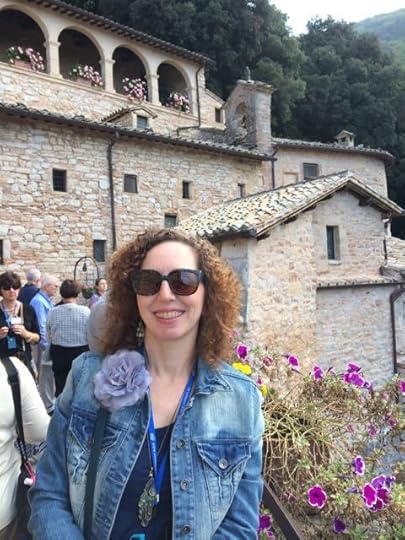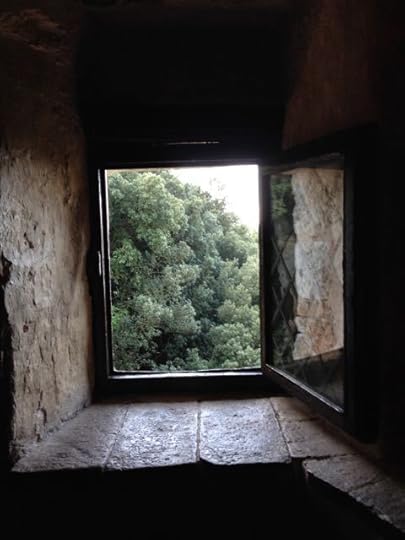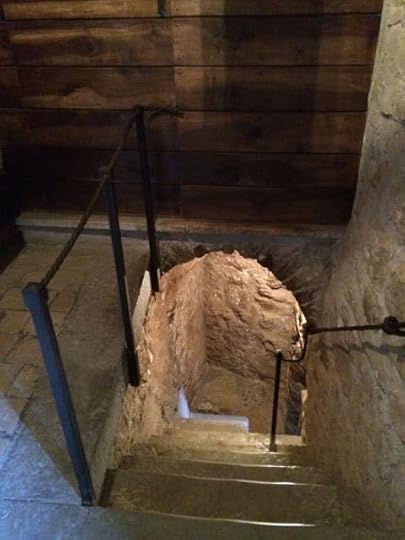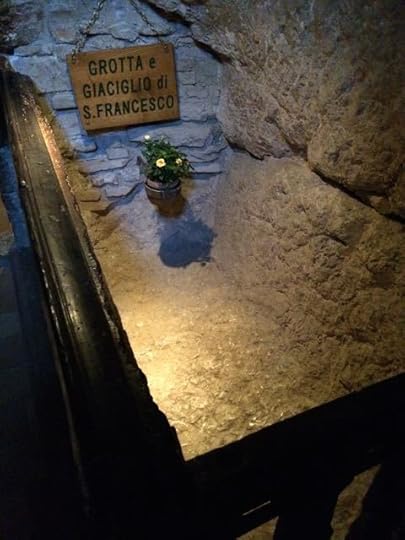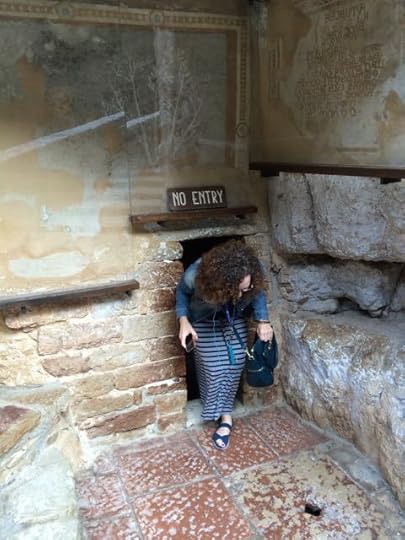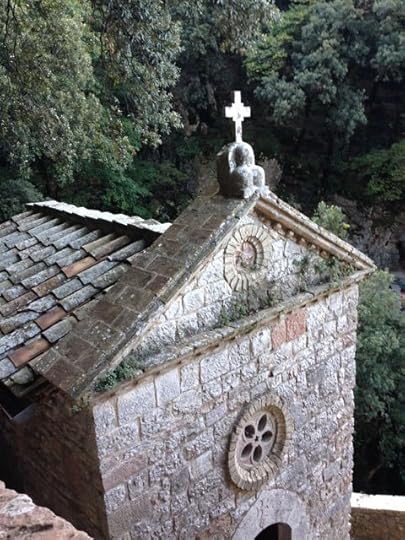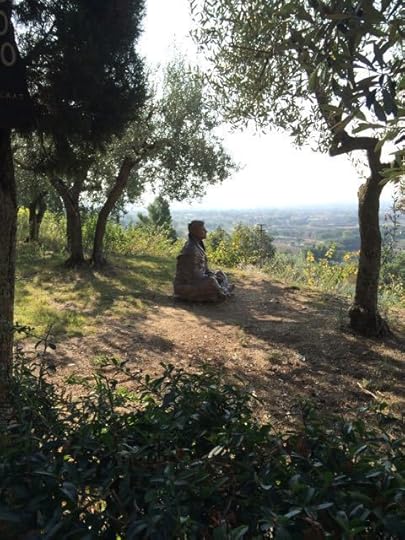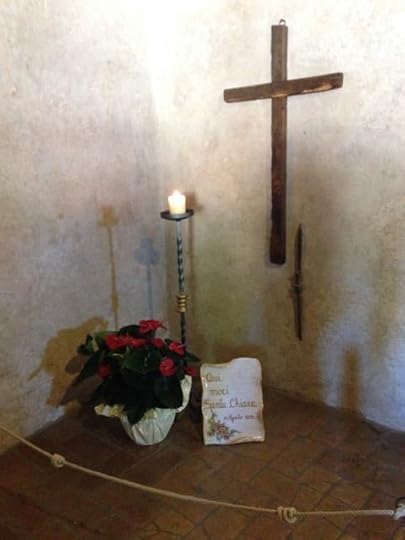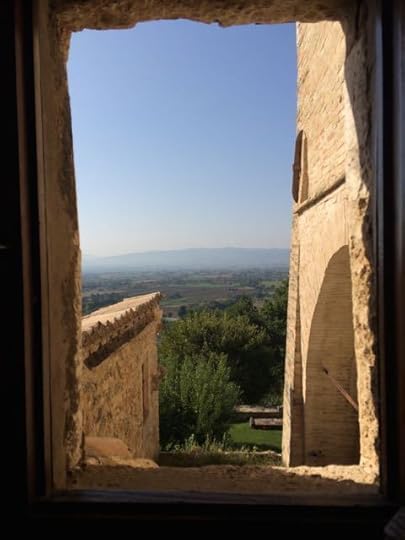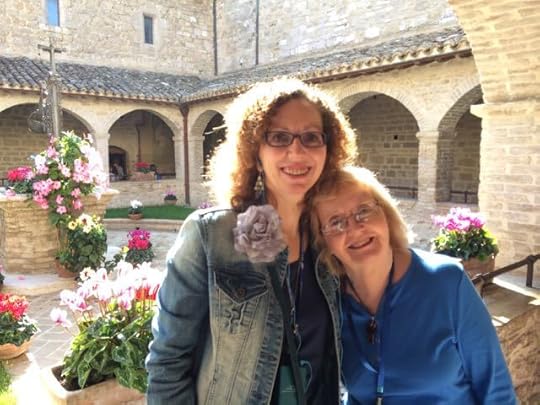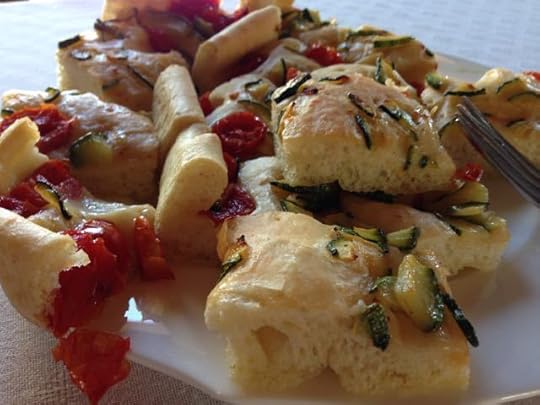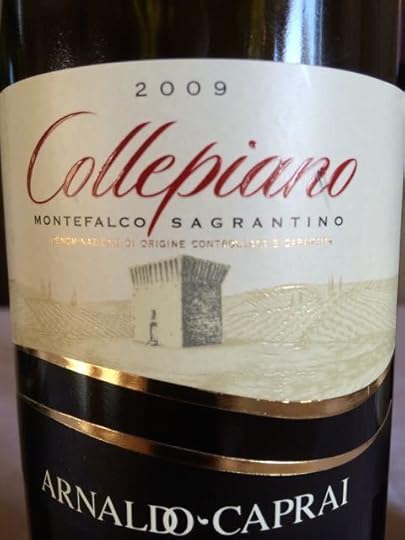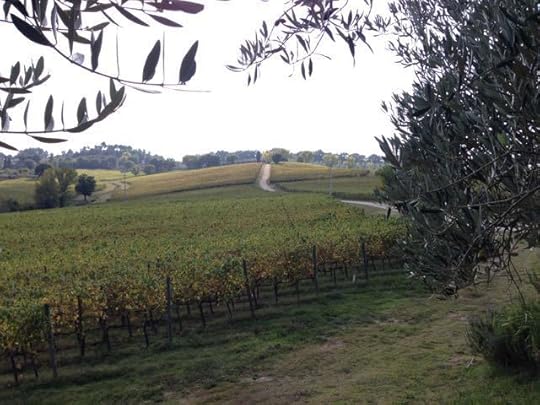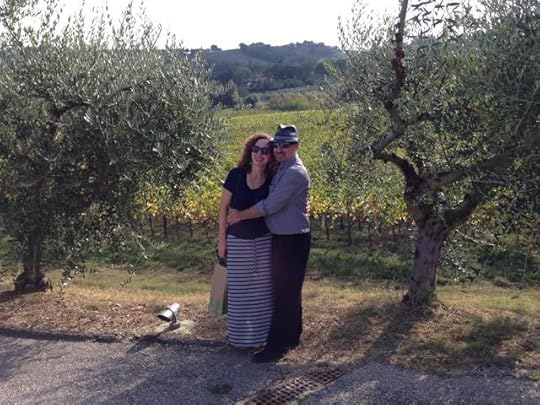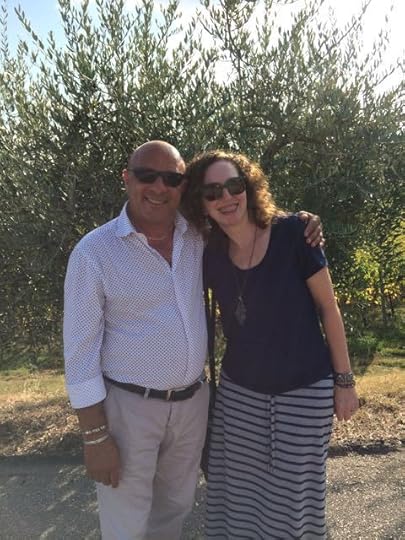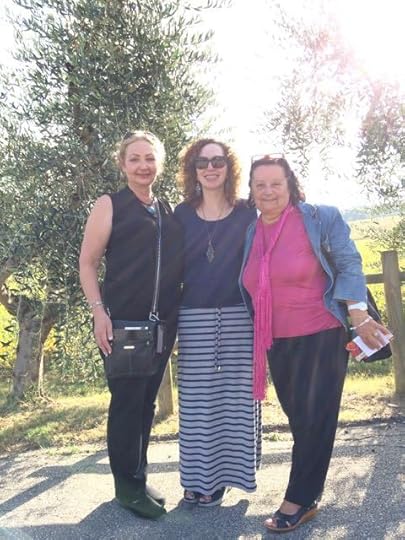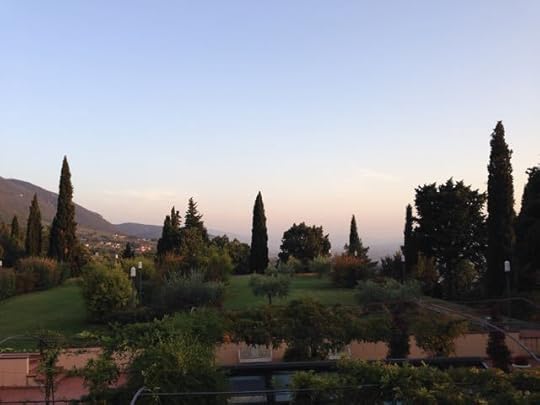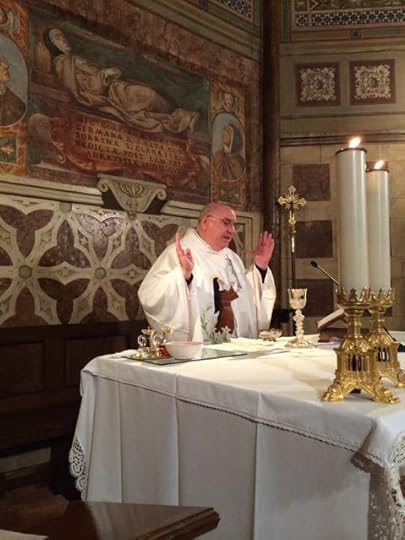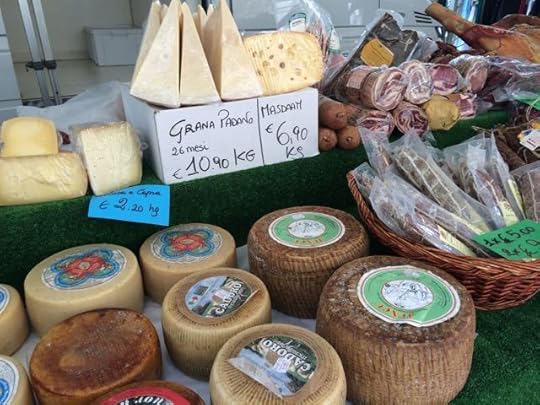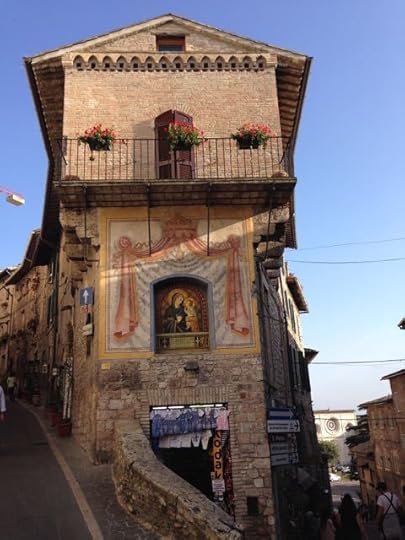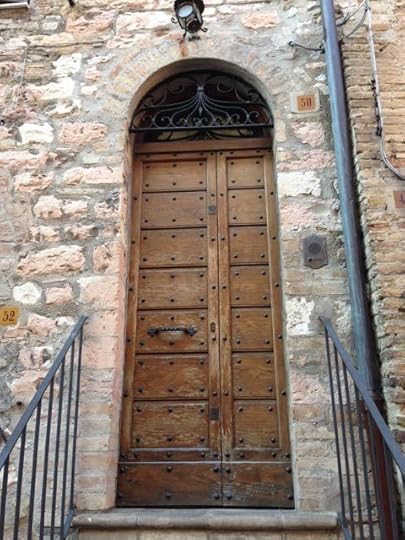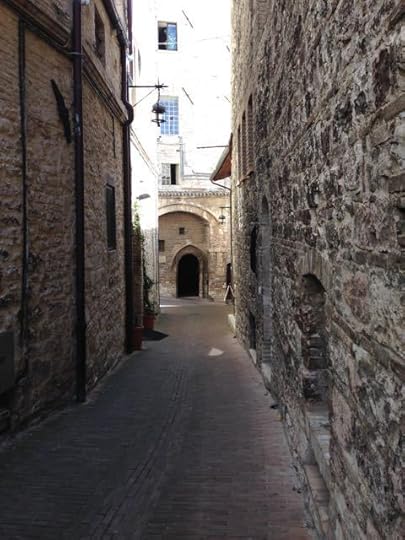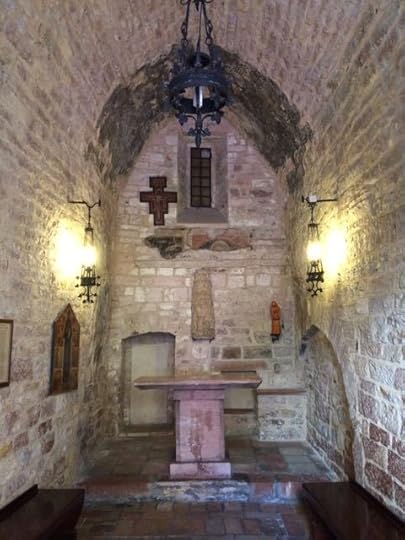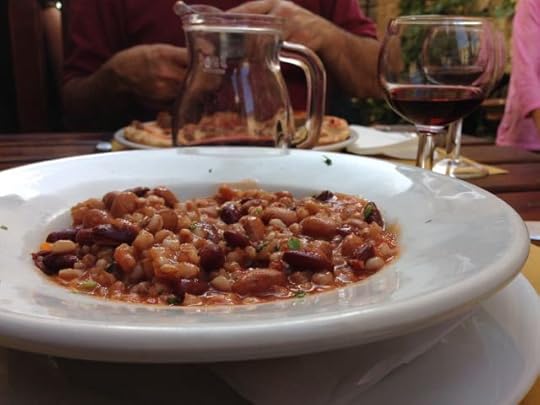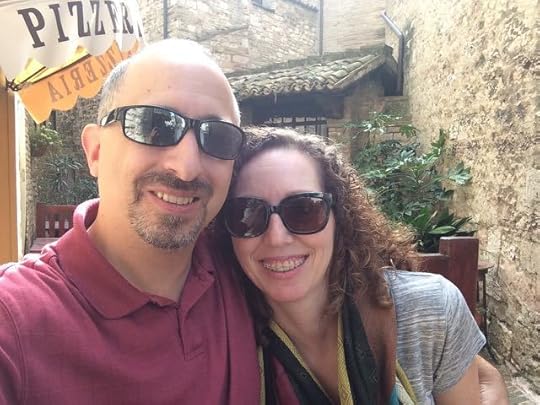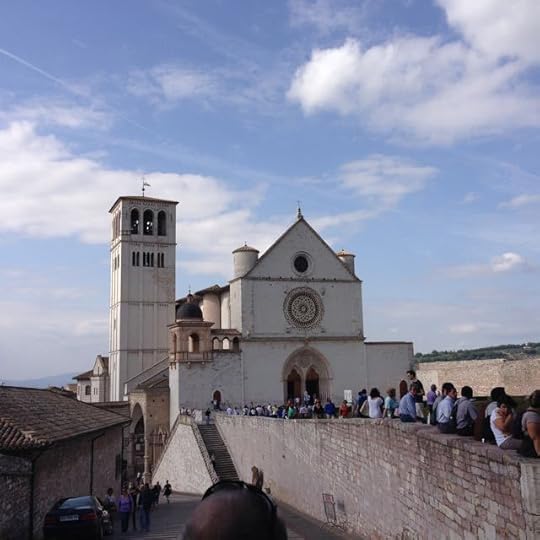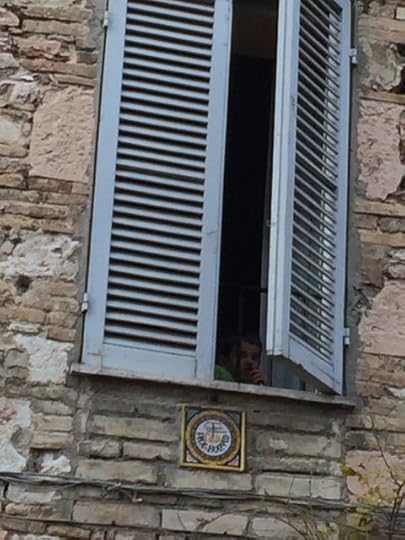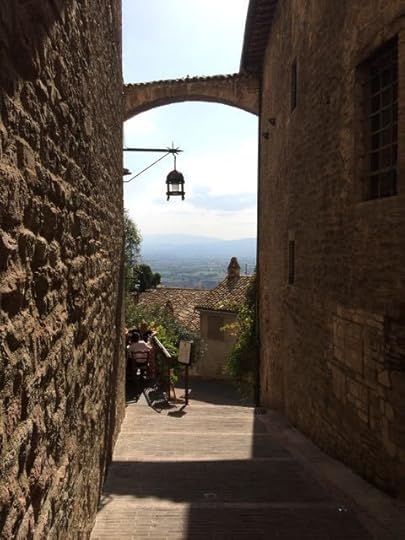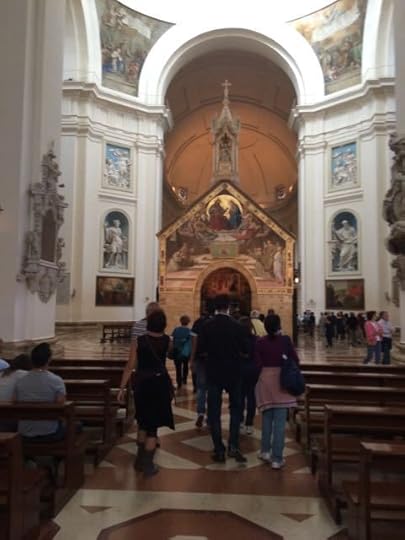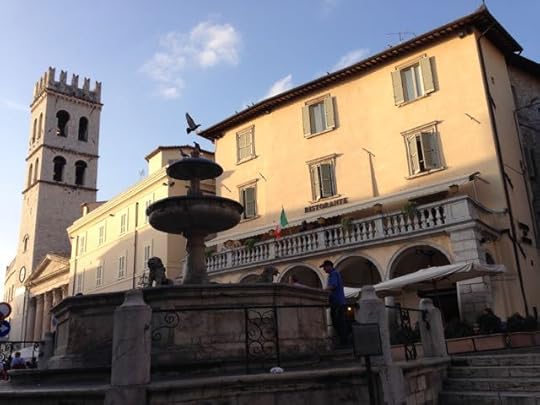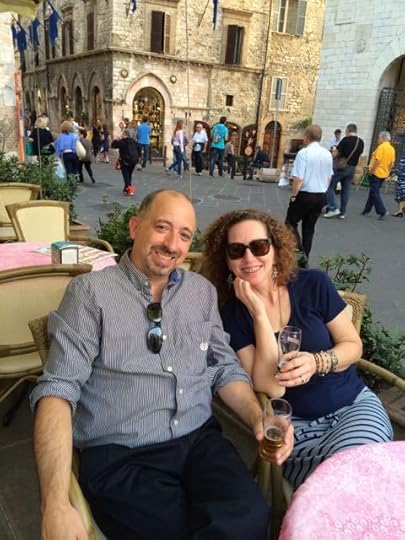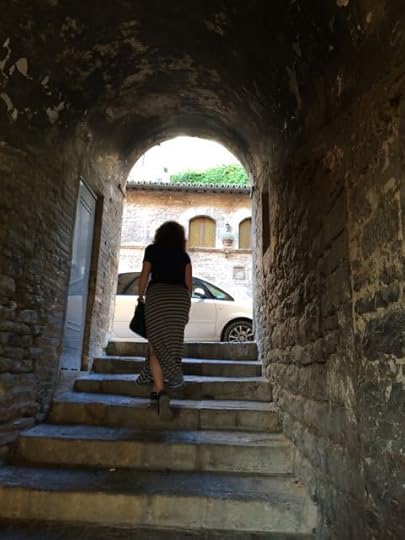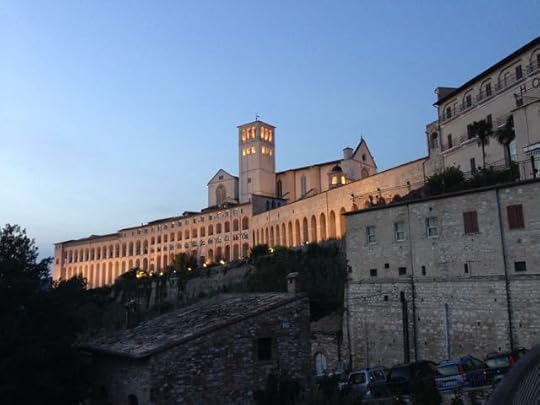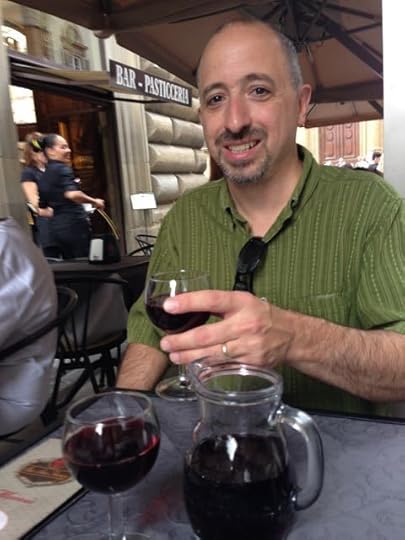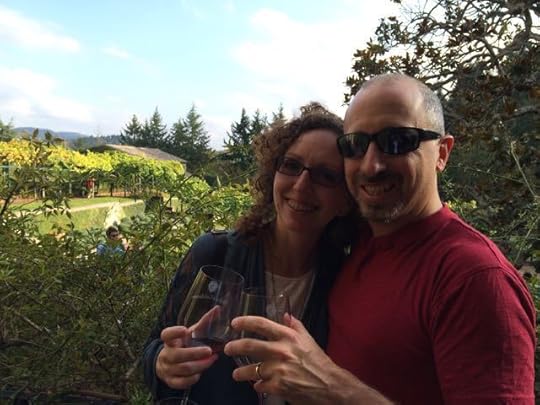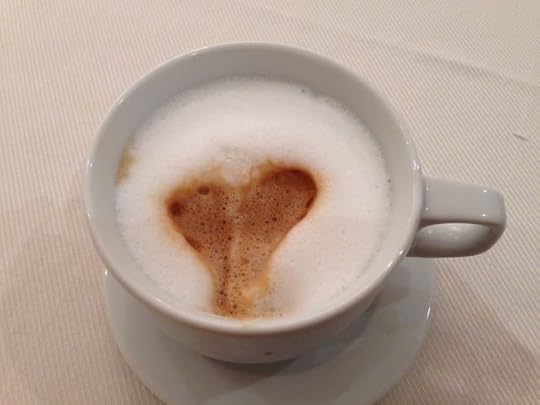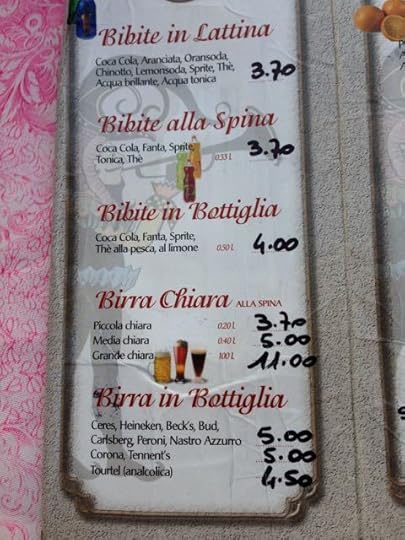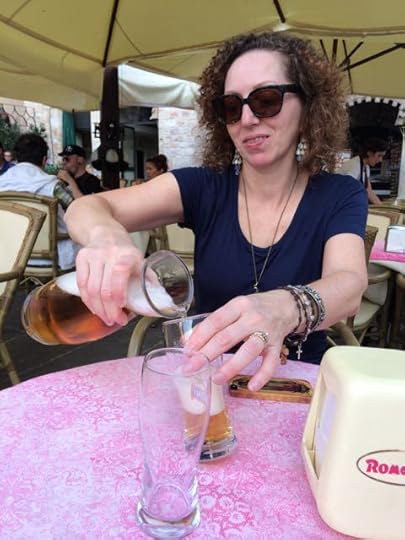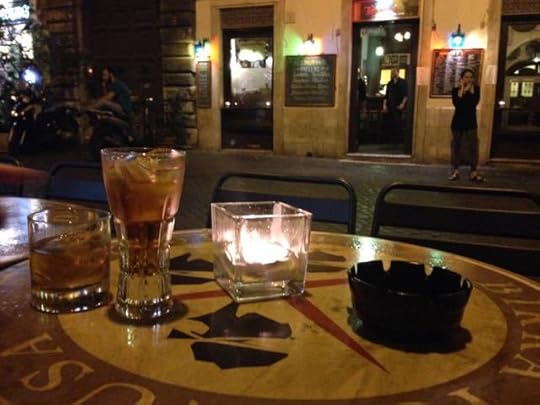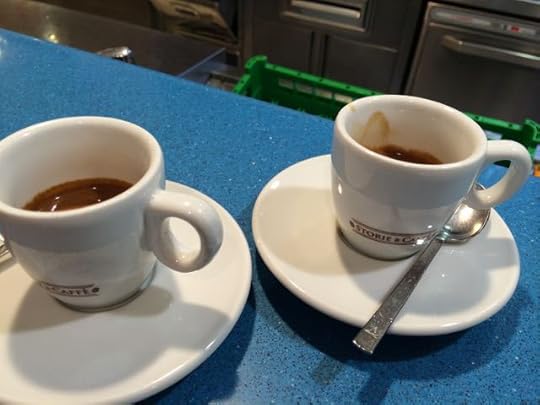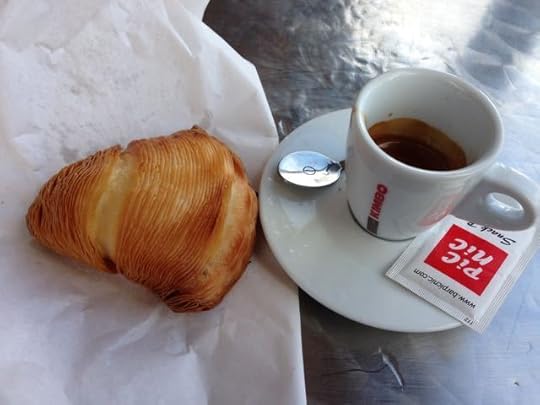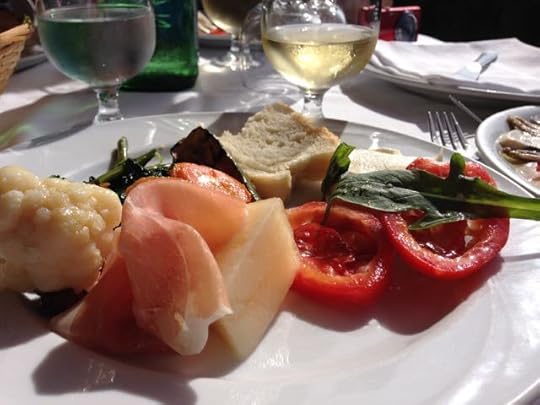Mary DeTurris Poust's Blog, page 33
November 30, 2014
This Advent, stop the clock and savor the season
Don’t let the frenzy of the season rob you of the chance to wait in wonder this Advent. Here’s my OSV Newsweekly story from last Advent to get you in the spirit:
By Mary DeTurris Poust
By the time Advent officially begins, most of us have been bombarded by so much Christmas music and Christmas advertising and Christmas everything that we’re already sick of the season. In a world where the Christmas countdown begins sometime before Halloween, it’s easy to lose sight of the beauty of Advent, and to get so caught up in the material trappings that we can’t see the spiritual forest for the tinsel-covered trees.
We live in a goal-oriented society, and in this case, Christmas is the end zone that we’re running toward at breakneck speed, hardly looking at what’s going on along the sidelines. But our faith beckons us to stop the madness, to stop the running, to focus on the journey as much as the destination. And to do that the Church gives us the four-week season of Advent, with its beautiful interplay of darkness and light, with its scriptural focus not only on the coming of the Christ Child but on the second coming of Jesus Christ, and with its quiet but constant insistence that we prepare — not just for a day but for a lifetime, and for the next life.
If we’ve been paying attention these past few months, we’ve been given some sound advice on how to do all this from Pope Francis, whose pastoral theme has been one focused on moving away from materialism and toward a deepening relationship with others and God.
“Brothers and sisters, let us call upon the name of Jesus,” Pope Francis challenged during his Nov. 3 Angelus address. “… And let us welcome him with joy: He can change us, can transform our hearts of stone into hearts of flesh, he can liberate us from selfishness and make our lives a gift of love.”
“Liberate us from selfishness.” Sounds like an Advent plan. So we start and end with Jesus, but how do we manage the days in between that are filled with things of a much less transcendent but somewhat necessary nature? It requires Herculean effort to silence the drumbeat of the secular version of this holiday and holy day. But by creating rituals and practices that refocus our attention on Jesus, we can bring some sanity, serenity and balance to the most difficult aspects of the season: the waiting, the buying and the praying amid the noise.
Waiting game
“Waiting is never easy, especially when we’re waiting for something as important and awesome as Christmas. Yet, the waiting itself is essential in properly preparing our hearts to welcome our Lord. If he just appeared suddenly — bing! Instant Savior! — then we wouldn’t have time for the prayer, meditation and contemplation that is required to reach the level of reverence that our hearts need and that he deserves,” said Marge Fenelon, author of “Waiting with Mary: Advent Reflections for Those Who Hate to Wait.”
“During Advent, the Church asks us to relive those weeks  before Mary gave birth to Jesus. No mother (not even foster or adoptive) welcomes a child out of the blue. There always is a period of preparation and anticipation. Advent is a time for us to imitate Mary’s pregnant motherhood — yes, even the guys — in that we await his birth in our hearts on Christmas morning. Savoring the waiting takes practice and determination,” she said. “To pull it off fruitfully, we need to focus on the waiting itself and how we’re approaching it spiritually. We need to plan spiritual exercises, customs, and quiet times that will lead us into, and hold us in, the attitude of holy expectation. If we don’t plan for a waiting-ful Advent, it won’t happen by itself.”
before Mary gave birth to Jesus. No mother (not even foster or adoptive) welcomes a child out of the blue. There always is a period of preparation and anticipation. Advent is a time for us to imitate Mary’s pregnant motherhood — yes, even the guys — in that we await his birth in our hearts on Christmas morning. Savoring the waiting takes practice and determination,” she said. “To pull it off fruitfully, we need to focus on the waiting itself and how we’re approaching it spiritually. We need to plan spiritual exercises, customs, and quiet times that will lead us into, and hold us in, the attitude of holy expectation. If we don’t plan for a waiting-ful Advent, it won’t happen by itself.”
Fortunately, the Church gives us a ready-made set of customs and exercises from which to choose. The Advent wreath is the most popular and familiar custom most Catholics use to mark the days of the season with prayer. But there are other opportunities to bring ritual and prayer into the season in ways that makes sense for you and your family. (See sidebar for Advent ideas.) Regardless of the method, the bottom line is prayer.
Everything is rooted in a prayerful watching and waiting. Fenelon, who says she wrote her book precisely because she lacks patience, told Our Sunday Visitor that prayer is essential if we’re going to try to slow down this season.
“Waiting is hard because we’re trained not to wait. Everything is instantaneous now — information, mental stimulation, recreation and even relationships. Digital technology puts it all right at our fingertips at a second’s notice … Prayer can’t be measured in gigabytes; it is measured in heartbeats. It’s also addictive. The more we pray, the more we feel the need to pray,” she said. “It can be a real struggle to reach the point of deeply fulfilling prayer when we’re feeling pressured by holiday preparations. We might not even feel like praying at all. That’s when we have to start with baby steps.”
Those baby steps can be something as simple as lighting a candle before dinner each night and stopping for just a minute to refocus attention on the sacred rhythm of the season, or it might be a conscious decision to avoid playing Christmas music or putting Christmas decorations up too early in the season. It’s not easy when “Jingle Bells” is playing from every radio station and when Santa is waving from every shopping center. But making an intentional effort to go against the grain will slow things down and allow you to savor the true beauty of Advent.
Consumerist culture
Perhaps nothing says Christmas like consumerism in mainstream America. We are living in a material world, and during the weeks and months leading up to Christmas, that fact is magnified to the point of the absurd. Gone are the days of handmade gifts and thoughtful trinkets. Now it’s not unusual for people to ask for gift cards, which is really just a polite way of saying, as Sally does in “A Charlie Brown Christmas,” “Just send money. How about tens and twenties?”
Quantity counts a little too much when it comes to Christmas these 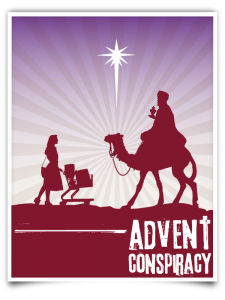 days, a point that is driven home by the folks at Advent Conspiracy, an organization that strives to make people aware of the over-the-top spending that goes on in the name of Jesus and offers ways to reverse that.
days, a point that is driven home by the folks at Advent Conspiracy, an organization that strives to make people aware of the over-the-top spending that goes on in the name of Jesus and offers ways to reverse that.
In a video clip that went viral when it was first posted in 2006 — and which has done the same every year since — Advent Conspiracy points out that Americans spend $450 billion on Christmas every year, most of it on credit. That’s a lot of stuff, most of it unnecessary.
The video encourages people to give more of their time and their love and themselves, and less of their paycheck and watch the magic start to happen.
“I think people want a different way because they see all this stuff they’re buying is not doing it … We give people permission to relax, to enjoy the season and to push back on the tendencies they have to buy,” Tony Biaggne, creative director of Advent Conspiracy, told OSV.
Biaggne said people innocently try to fill the empty spaces in their lives with material things because that’s what the world tells us will make us happy. Advent Conspiracy started asking people to consider cutting back on even one gift and distributing that money to a good cause.
What happened was staggering. The group has raised millions of dollars for Living Water International, which works to end the “clean water crisis.”
But Biaggne is quick to mention that Advent Conspiracy is an “upside down charity.” It didn’t start out as an effort to raise money; it started as an effort to raise awareness of Jesus’ importance in our lives.
“We gave people a chance to focus on Jesus. The natural outflow is love, grace and mercy. It just happens,” he said. “People desperately are searching for a chance to truly connect with the God of the universe who truly does give them a sense of peace on earth.”
But that doesn’t mean forgoing gifts and taking on a Scrooge persona. Instead, the idea is not to stop giving gifts, but to give more intentional gifts, not necessarily handmade gifts but gifts from the heart.
Gifts from the heart
What does that look like in our modern world?
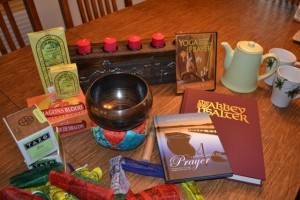
A bounty of thoughtful gifts I received from my husband one recent Christmas.
Well, it could be as simple as giving a child a “date” with mom or dad, a special day where they get to go somewhere or do something with a parent without interruptions or distractions like Facebook or work phone calls or TV.
Even gift cards can become heartfelt gifts when done right, said Biaggne.
“So if you give a gift card, you might say, ‘I know you love to shop at this store. The only catch is, I want to be with you and have lunch with you and shop with you,’” he said. “It becomes relational, and that redeems what seems like an empty gift.”
Biaggne is also quick to explain that Advent Conspiracy and other efforts to restore some sanity to the season cannot work without Jesus at the heart. He said that choosing not to include Jesus in a meaningful Christmas season is like choosing not to breathe oxygen when you take a breath. It can’t be done.
“You cannot enter into this without bringing your faith to the table and bringing Christ to the center of it and focusing on why the Christmas story matters,” he said. “It’s the most surreal, beautiful, most unexpected way that a Savior would enter into our world for all time.”
Change begins at home
So, for those of us just trying to balance the spiritual and the secular this season, how do we make it work?
“Forget trying to change the world and simply try to change your family,” said Al Kresta, president and CEO of Ave Maria Radio and author of “Dangers to the Faith: Recognizing Catholicism’s 21st Century Opponents” (OSV, $14.95). “You ask how Catholics can change. We won’t if we don’t recognize the seduction of consumerism. In spite of strong, even pointed, papal preaching, most Catholics still don’t feel that consumerism is much of a problem. It is, according to John Paul II, Benedict XVI and Pope Francis. Consumerism is the life orientation that our identities are formed by purchasing and consuming goods and services.”
Kresta told OSV that rather than scold others or society for the sad state of the Advent and Christmas season, do small things at home to make a difference where it counts — in the heart of your family.
That means, first and foremost, treating Advent as a season and an event separate from Christmas, rather than an extended shopping season.
“We sing Christmas carols all through Advent. We put Baby Jesus in our crèche scenes before the Nativity. Stop it. Don’t scold others about it. Stop it yourself and in your family. Try to enjoy the fact that our culture still has a way of recognizing the Incarnation, as inadequate a celebration as it is, and don’t be a scold. But be merrily different and when questions arise, enjoy making the point about Advent as a season of anticipation and the octave of Christmas as a season of thanksgiving,” he said. “One way to ensure that Advent will be a time of reflection rather than a time for commercial hype is to simply try and do as much Christmas shopping as possible the week before Advent begins. This requires more planning but I do know people who do and they exhort the rest of us to try. Advent, they say, has never been more meaningful.”
Biaggne from Advent Conspiracy also stressed the importance of doing small things that have the potential for big results. He suggested taking time to be silent now and then, saying that Psalm 46:10 — “Be still and know that I am God” – is his favorite go-to Scripture verse during the otherwise hectic season.
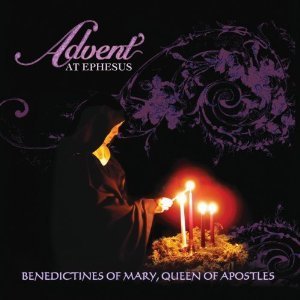
Advent at Ephesus by the Benedictines of Mary, Queen of Apostles, a beautiful soundtrack for the Advent season.
“I love that God is constantly trying to get us to shut up. Be quiet, not just physically, but turn off the buzzing in your head, turn off the quickening pace of your heart because of stress and know,” Biaggne said, adding that when we do that others pick up on the shift in us.
“They catch a whiff of grace. They notice we’re living differently, more at peace. ‘What’s your trick?’ they ask,” he said.
The answer is simple but not always welcome: Jesus, at the heart of Advent, at the heart of everyday life.
How does that translate into Advent action in Biaggne’s home?
He recalled how last year his 9-year-old son gave him a “date day” for Christmas. He made Biaggne his favorite pasta, served it up with sparkling grape juice, and asked his dad to talk about his life.
“It was a dinner I’ll never forget,” Biaggne said, reminding parents that their kids are not likely to remember the action figure or game they got years ago but the time you spent with them and the special rituals you created.
He recalled how his own father used to pick him up from his Catholic school to take him to a business club for Christmas lunch.“It wasn’t about what he gave me,” he said. “It was all about the time we spent together.”
Papal words, example
When we start to feel our spirits flagging as the push to conquer Christmas continues, we can look to Pope Francis for inspiration and guidance.
Although the message isn’t groundbreaking, he has put renewed emphasis on the dangers of materialism, a message that seems especially appropriate during this season of excess.
“Pope Francis perfectly follows the emphases of John Paul II and Benedict XVI on this matter of consumerism. The advantage that Pope Francis has is that he is living as close as possible to the very people he wants to reach and can better depict the immediate love of Jesus for the lonely, the poor and disabled. Like Jesus, he is with the people and by living with us he affirms our dignity and value,” said Kresta, who devotes a chapter to “Consumerism: Branding the Heart” in his book.
“To redeem means to buy us back from the slave market of sin. Consumerism sees redemption as a matter of coupon clipping or payment plans. It buys back products; Christ redeems persons. One of the purposes of the Incarnation is to break the bonds of consumerism,” Kresta explained. “Christ’s coming shatters its false scale of value so that we will no longer live enthralled by the impulses of the flesh, the seduction of the world or the manipulations of the devil. … We imitate the one who ‘though he was rich, yet became poor for our sakes’ (2 Cor 8:9). This strikes me as a particularly poignant theme for American Catholics to ponder during Advent.”
Advent Practices
The Advent wreath and the Advent calendar are classic traditions that keep Catholics focused on the “reason for the season,” but here some everyday Catholics offer ways they try to keep the spirit of Advent alive:
Have everyone in the family go to confession during the Advent season.
Cut up small pieces of yellow yarn or small pieces of cotton and each time someone does a good deed or acts like Jesus to someone else, he or she can place a piece in the crèche to prepare a soft place for the Baby Jesus.
Create an ‘Advent chain’ made of appropriate purple and pink paper strips to follow the liturgical colors of the season. Remove a link each day. Links can include a prayer, a Scripture quote or good deed.
Celebrate St. Nicholas Day on Dec. 6 by leaving a token gift — an orange, a piece of chocolate — in each child’s shoe. Then talk about the real St. Nick.
Participate in a giving tree or some other opportunity to adopt a family or child who will otherwise not receive any gifts this Christmas.
Serve lunch at a local soup kitchen before you head to your family celebration.
Create your own Jesse tree with a branch from your yard and some handmade ornaments. Talk about the meaning behind each symbol.
Turn your tree-trimming into a new tradition, either by chopping down your own tree or by blessing the tree as a family or by having a special dinner the night you decorate it. If possible, hold off on putting up the tree until the O Antiphons begin on Dec. 17, no easy feat in this rush-the-season world of ours.
Help your children make gifts for their siblings, parents, grandparents and friends: pictures, stories, dates out, free baby-sitting. Let kids get creative.
The post This Advent, stop the clock and savor the season appeared first on Not Strictly Spiritual.

November 29, 2014
The Catholic Worker and the Quiet Beatle
Today we honor two of my favorites: Dorothy Day and George Harrison, a seemingly unlikely pairing on the surface but not such an odd couple when you dig a little deeper. Day died on this day in 1980, and Harrison died on this day in 2001, forever linking the gritty would-be saint and the decidedly sage-like musician. At least in my book.
Although I’ve long been a fan of Day and have read many of her essays and lots of excerpts of books about her and by her, I have never read The Long Loneliness: The Autobiography of the Legendary Catholic Social Activist in its entirety, just pieces here and there. Don’t ask me how I’ve gone this long without reading it, especially since it’s been sitting on the bookshelf in my office for years. That’s about to change.
In an unsuccessful battle with insomnia in the wee hours of the morning today, I wandered down to my basement office. I cleaned up papers and filed receipts, trying to do some work that didn’t require too much thinking. Then I sat down to read today’s reflection from Give Us This Day and noticed the short essay on Day, founder of the Catholic Worker movement, in honor of the anniversary of her death. Having just finished a book on walking the Camino before I went to bed, I was looking for something to fill the gap. Enter The Long Loneliness. Even in my semi-awake state, I was pulled into this book by Day’s familiar story and down-to-earth writing style from the get-go. Can’t wait to get back to it later tonight.
One classic quote from Dorothy Day before we move on to a classic song from George:
The greatest challenge of the day is: how to bring about a revolution of the heart, a revolution which has to start with each one of us?
So now I’ll leave you with a song. The most likely George Harrison song to post on a spiritual blog like this one would be My Sweet Lord, but when have I ever done what’s “most likely.” Instead I will post my favorite George Harrison song: While My Guitar Gently Weeps, from the Concert for Bangladesh in 1971. Bonus: Ringo Starr and Eric Clapton.
I look at the world and I notice it’s turning
While my guitar gently weeps
With every mistake we must surely be learning
Still my guitar gently weeps
The post The Catholic Worker and the Quiet Beatle appeared first on Not Strictly Spiritual.

November 28, 2014
After the feast, before the frenzy: Restoring serenity to your plate as the holiday season sets in
I don’t know about you, but I’m still full from yesterday’s Thanksgiving eat-a-thon. I can’t even think about food. Except for those pies on the counter. And the stuffing. Cold stuffing eaten right from the fridge. Oh, and wait, didn’t we have some leftover brie? Yeah, it’s going to a be a long and fattening weekend if I don’t rein in the cravings before they set me on a course to eat my way through the holiday season.
With all of that in mind, I thought today I would re-post the abbreviated version of a webinar I did when my book Cravings first came out. Five easy steps for shifting the food-diet-weight paradigm. If you can get beyond the Thanksgiving leftovers and through the Christmas season with these steps in mind, you might not have to resort to that same old resolution to lose five pounds, or ten, or twenty when New Year’s Day rolls around. Here you go…
How to Restore Sanity and Serenity to Your Relationship with Food
Believe it or not, the shift in your relationship with food starts not with what’s on your plate, but what’s inside your head. Here are five steps to restoring sanity and serenity to your relationship with food:
1. See yourself as beloved by God exactly as you are at this very moment.
What do you see when you look in the mirror? Most of us don’t see our true selves. We see our flaws magnified. So our self-image is often not based on reality. We allow a number on a scale to determine our self-worth, and wend up starving ourselves or stuffing ourselves in an attempt to become an imaginary person or to comfort ourselves for NOT being that person. So this process begins by our embracing “what is” not what we think should be. That doesn’t mean you don’t want to improve. Maybe you’d like to lose a few pounds or need to lose weight for health reasons, but you begin from a place of knowing that you are wonderfully made even before you start. You begin with self-acceptance and the knowledge of God’s unconditional love.
2. Trading multi-tasking for mindfulness.
In our culture today, multi-tasking is looked upon as a badge of honor. We don’t feel we’re working hard enough if we’re not doing at least three things at once. Becoming more mindful is absolutely necessary on this path. Here’s how you can start:
When you eat, just eat. Do one thing at a time.
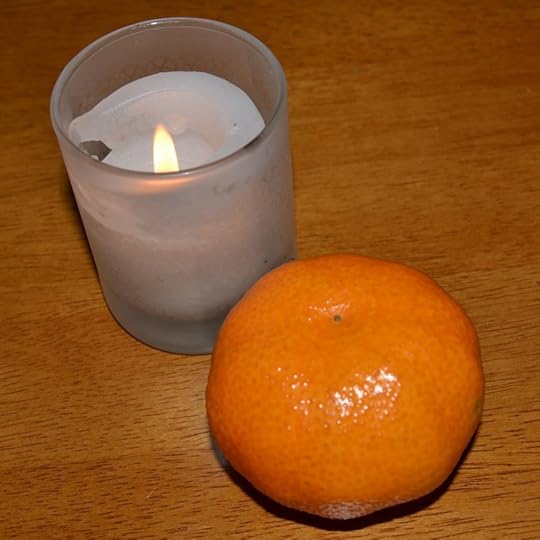 So when you’re going to eat breakfast or lunch or dinner or even a snack, stop everything else. No driving, no talking on phone, no working at desk, no crossword puzzle on the table. When you strip away all the externals distractions, it’s just you and your food. Suddenly you’re very much aware of everything you’re eating, that you’re eating at all.
So when you’re going to eat breakfast or lunch or dinner or even a snack, stop everything else. No driving, no talking on phone, no working at desk, no crossword puzzle on the table. When you strip away all the externals distractions, it’s just you and your food. Suddenly you’re very much aware of everything you’re eating, that you’re eating at all.Begin every meal with prayer. Whether you start with a spontaneous blessing, a traditional prayer, intentions for family and friends, or simply the Sign of the Cross, prayer can set the tone for your meals. Taking even just a minute to stop and quiet your heart and mind before eating shifts the landscape and tends to make you much more aware of your blessings, your food, and your journey. And just as important as prayer is keeping a positive energy at the kitchen table or office cafeteria table. Mealtime is not the time to argue or discuss problems or get angry or upset. It’s almost like you’re ingesting the tension, and that certainly isn’t good for your physically, mentally, or spiritually.
Start a food journal. This isn’t to count calories or fat grams but to continue to build awareness. Jot down what you eat but also when and if there’s anything in particular that’s bothering you or upsetting you. Start to notice if and when you grab for food when you’re not hungry. Make these notes without judgment. This isn’t about making yourself feed bad, but about becoming aware of the deeper hungers you may have.
3. Develop some new food rituals.
Create some new rituals to change your relationship with food. For me this started with what I call my “mindful oatmeal,” breakfast eaten in silence, with a lighted candle, no distractions, and deep prayer. The idea is not to always feel like you’re sacrificing, but to come up with new and different ways to enjoy food while giving it its rightful and healthy place in your life. Try to build in some sacred moments and daily doses of joy.
 Is there a particular food you love but always avoid because it’s on the forbidden list? Create a ritual around this food. Maybe it’s chocolate. Rather than depriving yourself over and over and then, when you just can’t stand it anymore, scarfing down an entire bar of chocolate, develop a nightly ritual. Perhaps one square of dark chocolate eaten slowly off a nice dish in front of the fire or shared with a family member on the living room couch and savored slowly. Start to see that learning to get beyond your cravings doesn’t mean denying yourself but filling yourself up with more than just food.
Is there a particular food you love but always avoid because it’s on the forbidden list? Create a ritual around this food. Maybe it’s chocolate. Rather than depriving yourself over and over and then, when you just can’t stand it anymore, scarfing down an entire bar of chocolate, develop a nightly ritual. Perhaps one square of dark chocolate eaten slowly off a nice dish in front of the fire or shared with a family member on the living room couch and savored slowly. Start to see that learning to get beyond your cravings doesn’t mean denying yourself but filling yourself up with more than just food.
4. Begin to bring balance to your life.
We can look to our faith to see that balance is key when it comes to celebrations and even everyday food. Throughout the Church year we feast and fast. We can’t feast all the time. And so it is in daily life. There has to be balance. Fasting from the noise of life now and then can help us hear our true cravings. Try to find five minutes of silence every day. It doesn’t sound like much, but if you’re not spending any time in silent solitude, you will be amazed by what just five minutes a day will do for you. Slowly increase to 10, 15, even 20 minutes, if you can. Use this time to rest in God, just listening for the whisper of the Spirit. This prayer time will be an important part of keeping that balance we’re talking about, and you’re likely to find that it’s not only helping you with your food issues but with so many other things as well.
5. Celebrate food
This last step really encompasses all the others and then takes them to the next level. If you are someone who is constantly hoping to lose weight or improve your diet and deal with your food issues, you probably love food and eat lots of good food but you may not CELEBRATE food because it’s too tied to guilt and bad feelings and regret. This last step is a huge one because the end goal is to finally break those food-Is-the-enemy feelings and find the place where you and food happily coexist in such a way that brings peace to your life and, eventually, the healthy weight and diet you crave but without all the angst.
Look at the big picture. This is not just about eating food. This whole mentality and perspective on diet and self and God is really about taking a healthier approach to ALL aspects of food and eating – from what you buy, to how you prepare it, to how you serve it, to how you eat it, even to how you clean up. The Mass offers us a model. We don’t drive up to a window, grab the host, and eat Communion in our car as we drive home and talk on the phone. We go into church and ready our hearts and minds for what we’re going to receive.
 The parts of the meal are brought to the altar with love, the priest prepares the gifts with reverence and prayer, and then we approach quietly and take Communion and then return to our seats to reflect on what we’ve just received. How can you bring some of those sacred elements into your meals at home?
The parts of the meal are brought to the altar with love, the priest prepares the gifts with reverence and prayer, and then we approach quietly and take Communion and then return to our seats to reflect on what we’ve just received. How can you bring some of those sacred elements into your meals at home?Community. Another important element of Mass that directly connects to our food life outside church is the importance of community. We share in our sacred meal at Mass by joining our brothers and sisters for the feast. Do we experience that at home or at parties? We don’t need buffet tables piled to overflowing with every kind of fried food or heavy dessert to enjoy a party or a meal. What we need is community, which provides us with opportunities to be fed and satisfied on a deeper level. It’s just a matter of taking a new view of what a party or feast should be.
Lessons from the monastics. We can learn a lot about food and its place in our life and its connection to the sacred can be learned from the monastics. Eating in season, eating in moderation, eating locally and organic, eating slowly – all of these things have been part of monastic life for centuries. We can follow their lead and begin to choose more carefully the food we make and serve and how we approach the preparations, the serving, the clean-up. Of course, I’ve had multiple people remind me that lots of monks are overweight and so they can’t be a model. And to that I say, “You’re missing the point!” The whole focus of Cravings is not on becoming an ideal weight or size but on accepting who you are right now. I think monastics, whether thin or overweight, offer us a pathway that’s healthy in that it strips food of its power to make us afraid or guilty or unhappy and reminds us that food is meant to nourish our bodies, but only God can nourish our souls. When we combine the two, we have a powerful way to put food in its rightful place. We can celebrate food without being ruled by food.
So what are you craving today? The next time you’re about to reach for something to eat, stop for a moment. Breathe, become aware. If you’re really hungry or if it’s mealtime, put away everything else and say a blessing. Sit down to eat. Slow down to eat. Smell your food. Look at your food. Chew your food with attention and INtention. Enjoy the people around you if you’re not eating alone. Savor not just the taste of what you’re eating but the atmosphere, the beauty of the world – even if it’s just your own kitchen. There is beauty there. After all, God moves among the pots and pans.
For a more thorough exploration of this topic, including practical exercises, meditations, discussion questions, and many personal stories, order a copy of Cravings: A Catholic Wrestles with Food, Self-Image, and God.
The post After the feast, before the frenzy: Restoring serenity to your plate as the holiday season sets in appeared first on Not Strictly Spiritual.

November 24, 2014
3 steps to a more grateful life
My story on gratitude and how it can change your life, running in the Nov. 24 issue of OSV Newsweekly:
German mystic Meister Eckhart once said, “If the only prayer you said your whole life was ‘thank you,’ that would suffice.”
Gratitude has that kind of power, not just in prayer, but in the most ordinary moments of our lives. When we are thankful, grateful and appreciative of what we have — even the things that don’t necessarily warrant a special thank-you prayer — we tend to be more generous, loving, patient and kind toward others.
Gratitude shifts our focus away from our own complaints and problems. If we are busy noticing the blessings in our lives — even something as simple as a beautiful sunrise coming up over the highway as we drive to work, or our family gathered around the dinner table after a long day — we are less likely to wallow in self-pity.
But that doesn’t mean developing an attitude of gratitude is easy. It requires action and determination to look for those moments of grace, even when they are hidden among the thorns of disappointment.
“To be grateful is a characteristic of humility, and that in itself opens the heart to grace, opens the heart to others, and allows you not to put yourself at the center of the conversation but others,” said Father Francis Hoffman, JCD, executive director of Relevant Radio, who is known as Father Rocky. “Gratitude naturally takes us away from ourselves and opens us to others and to God, and that always brings joy with it.”
Be intentional
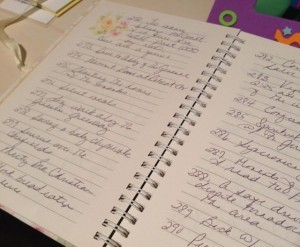 Those who count their blessings in concrete ways — written in gratitude journals or on slips of paper collected in a gratitude jar or box, even on Facebook for all the world to see — do seem to give off a sense of joy, one that ripples outward, as if every blessing they name is a pebble tossed into our collective consciousness.
Those who count their blessings in concrete ways — written in gratitude journals or on slips of paper collected in a gratitude jar or box, even on Facebook for all the world to see — do seem to give off a sense of joy, one that ripples outward, as if every blessing they name is a pebble tossed into our collective consciousness.
“I like that idea, writing down a list of things that you should be grateful for. I encourage people to begin with the things that you take for granted,” Father Rocky told Our Sunday Visitor, suggesting people start with simple blessings, such as being able to walk and talk, or having a warm home and running water, because too often we’re “out of touch” with the reality that many people in our world don’t have the most basic things.
A gratitude practice can be as simple as opening up a cheap spiral notebook and jotting down, on a daily basis, the things that bring a smile to your face, from the ridiculous (your cat batting a crumpled piece of paper around the house) to the sublime (a good diagnosis from the doctor).
Even the smallest nods toward gratitude remind us that the goodness we experience comes from somewhere outside ourselves, from “a benevolent source of life,” said Bishop Edward Scharfenberger of the Diocese of Albany, New York.
“It stimulates the hope that we are not alone, isolated or abandoned,” Bishop Scharfenberger told OSV. “At the same time, gratitude is a response that makes a demand on our own creativity. It challenges us to become more than what we are and, therefore, to grow out of any vicious cycle or stagnant state — such as worry, fear, helplessness or even victimization. It is both a gift and a call.”
Robert Emmons, a professor of psychology at the University of California Davis, conducted a scientific study that demonstrated how actively being grateful can positively affect both physical and emotional health.
According to his study results, participants who kept weekly gratitude journals “exercised more regularly, reported fewer physical symptoms, felt better about their lives as a whole, and were more optimistic about the upcoming weeks compared to those who recorded hassles or neutral life events.” He also found that those who kept gratitude journals were more likely to accomplish personal goals and to help others in need of support or assistance.
Elizabeth Figueroa, a clinical social worker based in Georgia, told OSV that humans are wired for connection, and gratitude is “a lens through which we can notice ordinary places of connection in our day-to-day lives.”
By practicing gratitude, we train ourselves to pay attention to small moments of grace found amid the mundane moments of life.
Figueroa said that gratitude is appealing because it’s universal.
“The practice of cultivating awareness is central to spiritual and psychological worldviews alike,” she said. “Over the past few decades, the field of psychology has become more open to spirituality, and popular spirituality has drawn upon the gifts of psychology.
“Gratitude, it seems, is a practice in which spirituality and psychology have found common ground,” Figueroa added. “Science is finally confirming a truth that spiritual people have known for centuries: cultivating gratitude makes us happier, less isolated and more connected to ourselves, to others and to God.”
Be prayerful
Father Rocky recommends people use vocal prayers, such as the Angelus, grace before meals and prayers of thanksgiving after Communion, as well as mental prayer to focus their gratitude, expressing thanks for everything from grace and mercy to the Blessed Mother and the Holy Spirit to music and sports.
When it comes to gratitude, nothing is out of bounds.
Father Rocky says people who manage to maintain an attitude of gratitude even during deep sorrows and struggles do so from a place of God-given grace.
 “That takes faith, doesn’t it?” he said. “And faith itself is a gift. Every priest has come across people who are objectively in painful and difficult situations and discover that they have this marvelous peace and serenity and joy in the midst of the cross, and it’s not a natural experience; it’s a supernatural experience because they have this deep faith in God that is at work in all of this. The expression of gratitude in those circumstances is almost like a barometer of the faith we have.”
“That takes faith, doesn’t it?” he said. “And faith itself is a gift. Every priest has come across people who are objectively in painful and difficult situations and discover that they have this marvelous peace and serenity and joy in the midst of the cross, and it’s not a natural experience; it’s a supernatural experience because they have this deep faith in God that is at work in all of this. The expression of gratitude in those circumstances is almost like a barometer of the faith we have.”
That’s not to say that if we get angry and upset we don’t have faith, because it is only natural to get angry and upset with God sometimes. In those cases, both Father Rocky and Bishop Scharfenberger recommend adoration in front of the Blessed Sacrament, meditation on the mysteries of the Rosary and confession.
“You can really feel the grace working within you to change, to say, ‘I’m sorry, please forgive me, and I’d like to begin again.’ We can get caught in that downward spiral, and we break the spiral by God’s grace, which comes from contrition but also through the sacraments. They’re very helpful,” Father Rocky said. “Grace really affects us, really improves us.”
According to Figueroa, true gratitude doesn’t ignore life’s difficulties but, instead, locates God “precisely in the midst of the messy places.”
“Gratitude does not pretend that challenges do not exist; instead, the practice of gratitude can help us find God in these challenges. Not only does gratitude push us to discover places of abundance over scarcity, it also teaches us that God is present even amidst the scarcity,” Figueroa said, adding that it’s something she has to continually practice in her own life.
Once you begin to develop that attitude of gratitude, it grows and spreads.
“Then you can recognize God in people around you, and in nature, and in the seasons, and in everything,” Father Rocky said. “It allows in the presence of God and opens you to a situation of joy.”
Be humble
Bishop Scharfenberger stressed that frustration over the struggles we may encounter in daily life — and even the most grateful among us feels frustrated now and then — can be a sign that our growth and potential are being blocked.
 So for those of us who often find ourselves stuck in a moment of sadness, anger or despair, there’s no reason to lose hope or think that we, too, can’t move ourselves back toward gratitude and joy. The key, however, is realizing that we can’t do it alone; rather, we need God’s help.
So for those of us who often find ourselves stuck in a moment of sadness, anger or despair, there’s no reason to lose hope or think that we, too, can’t move ourselves back toward gratitude and joy. The key, however, is realizing that we can’t do it alone; rather, we need God’s help.
“Gratitude becomes a recognition and a confession that ‘I need a savior,’ that ‘I cannot save myself. The source of any hope lies outside myself,’” Bishop Scharfenberger said. “Gratitude is more than an attitude or a habit or a tendency; it is a relationship with my Lord and savior, Jesus Christ. It goes beyond being grateful for the gift of life and all the good things of the world, even the gift of family and friendship.
“It is gratitude for being rescued from the pit of darkness by the Lord, who chose to save me even before I realized I needed to be saved,” he added. “It is in such darker moments that what gratitude really means becomes clearest and most real: gratitude is a relationship with that person who loves me with an unconditional love. The only just response to the call of that gift is gratitude.”
Of course, not everyone is inclined to see even dark moments as a gift, and that is why we need to nurture the practice of gratitude when times are good. If we lay a strong foundation of faith focused on our blessings, we will have something to shore us up when those storm clouds inevitably come rolling in.
“I’ve found that a gratitude practice helps us to notice what is already taking place in our ordinary, daily lives,” Figueroa said. “Gratitude opens up a new world to us, when we start to notice the gifts that are always available to us, always surrounding us, waiting to be seen. Gratitude can give us new eyes to see what has been there the whole time.”
It’s critical, too, to remember that God is always present.
“Even in the most desolate of circumstances, we are oftentimes surprised by the abundance of gifts that somehow, impossibly, seem to show up — a kind look from a stranger, a nurturing friend, a new insight or glimpse of hope,” she added. “God provides us with enough, and a practice of gratitude can help us notice this.”
Click HERE for my related feature on three people who are living examples of these gratitude practices.
The post 3 steps to a more grateful life appeared first on Not Strictly Spiritual.

November 19, 2014
It’s never okay to play Grand Theft Auto
Grand Theft Auto, the violent bestselling video game franchise, was in the news again this week for upgrading its game to allow players to have sex with a prostitute from the player point of view. If you have kids, or if anyone in your house is playing this game and you haven’t checked it out, you need to do that today. Perhaps you’ll change your mind about whether your child is old enough or if anyone at all should ever be playing this game. Bottom line: They shouldn’t. Not only does it glorify crime and violence, but now it lets you or your child watch as a prostitute performs sex acts on you, moaning all the way. The audio alone should be enough to make any parent rethink this as an entertainment option for their kids — no matter how old they are.
But, wait, there’s more great stuff your kid can do in this latest version. Read this:
The icing on this controversial cake is the ability players have to then gruesomely murder their prostitute and take back their money.
 Still not convinced that this game is not only bad for children but bad for adults and bad for women and bad for society? Go on Youtube and search Grand Theft Auto V and you can see for yourself. It won’t be hard to find. I’m not linking to it here for obvious reasons.
Still not convinced that this game is not only bad for children but bad for adults and bad for women and bad for society? Go on Youtube and search Grand Theft Auto V and you can see for yourself. It won’t be hard to find. I’m not linking to it here for obvious reasons.
I am so beyond offended by this game, as a woman, yes, but as a human being even more. And I’ve always been offended by this game, not just for how women are portrayed and treated on screen but for the over-the-top violence that is rewarded with points. And even before this latest version put sex into the hands of the controller, prostitutes were part of the on-screen world. Now it’s just a lot more graphic and offensive.
How is it possible that we find this okay, that this is a bestselling video game? Where are the feminist voices speaking out against this kind of misogyny? I’m dumbfounded. I sort of insulate myself from this sort of thing. We don’t allow it in our house, and to a large extent I don’t allow it into my mind because letting it into my mind puts images of violence and murder and beating of women there, and that’s not good for me, or anyone. Which is why it’s bad for society. When people spend hour upon hour using their controller to kill people, steal things, hire prostitutes, beat women, it begins to blur the edges of what’s okay in real life. It desensitizes us to violence, which is why the the military uses video games to help soldiers get over the innate human aversion to killing. My husband, Dennis, interviewed a lieutenant colonel in the army about this for OSV Newsweekly years ago, and now this expert has a new book out specifically on this topic, Stop Teaching Our Kids to Kill.
Video games — especially first-person violent video games — do affect us, even if we don’t realize it at the time. We can choose what we let into our homes and what we let into our heads.
The post It’s never okay to play Grand Theft Auto appeared first on Not Strictly Spiritual.

November 18, 2014
A Moveable Feast: Assisi, outside the city walls
Yesterday we spent the day — two days, really — wandering around the city of Assisi. Today we’re going to venture outside the city walls. On our second day in Assisi, we visited the Hermitage of St. Francis, the Church of San Damiano, and a fantastic winery-agriturismo outside Assisi in the town of Montefalco.
Our trip to the Hermitage of St. Francis (Eremo delle Carceri) was well worth the early drive via taxis (because the road is too narrow and winding for a tour bus) to the retreat on the slope of Mount Subiaso. This is where St. Francis and his friars came to get away from the busyness of life and pray in silence and solitude. The views were stunning, but the fact that we were able to touch the walls of the cell where St. Francis once slept was pretty overwhelming. Here’s a quick visit to the hermitage in photos.
Entering the hermitage. Can you tell I can’t get enough of this St. Francis stuff?
The chapel where St. Francis prayed…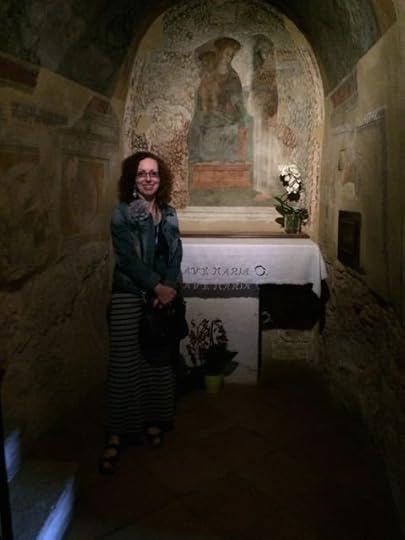
Looking out from the hermitage…
Narrow stairs leading to St. Francis’ cell…
St. Francis slept here in this little cave. I just kept running my hand over the wall, trying to grasp the fact that I was actually touching a wall that St. Francis surely touched as he came and went from this cell.
Exiting the cell. Obviously St. Francis wasn’t a very tall fellow…
Hermitage beauty…
Out on the grounds…Imagine St. Francis looking out at that view and praying his Canticle of Brother Sun and Sister Moon.
After the hermitage, we headed to the Church of San Damiano, where St. Clare and her Sisters lived. Msgr. Benwell again celebrated Mass for us while we were there. Here’s the spot where St. Clare died:
Here’s the window where she stood holding the Eucharist, eventually turning back attacking forces.
The flowers mark the spot where St. Clare prayed each day.
Me with my godmother, Aunt Margaret, in the cloister garden at San Damiano.
From there our fearless bus driver, Sergio, managed to drive our giant bus up some very narrow, winding country roads and around hairpin bends — even backing our bus back down a road that was just too small — so that we could eat lunch at the Arnaldo-Caprai winery, an agriturismo that serves only what it grows and makes on its own grounds. Here’s one view: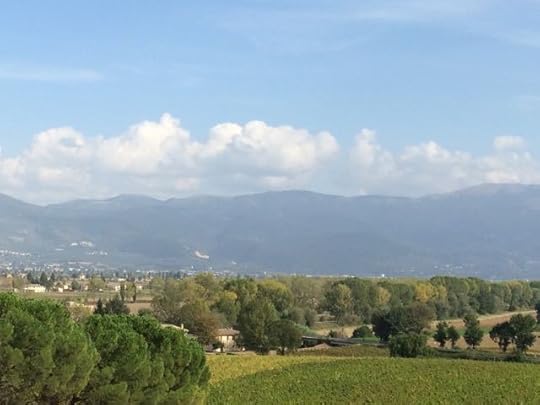
Our antipasto. Actually this was just one small part of our first course. Not enough room for all those photos.
Our segundi — the best rigatoni I have ever had.
Our favorite of the many wines we tasted.
Back out on the grounds…
Me and my sweetie at the winery.
The best bus driver ever: Sergio.
And…the three musketeers of the pilgrimage: On the left, Melani of Joyful Catholic Journeys — the one who got this whole food-faith pilgrimage rolling two years ago; yours truly; and Isabella, the most amazing tour guide ever. She MADE this pilgrimage. So talented, so hard-working, so funny and knowledgeable. We were truly blessed to have her as our guide from start to finish. To be honest, I can’t imagine going back to Italy with out her.
And finally…a return to our hotel for a last dinner in Assisi. This is taken from the window of our room with a view. Yeah, amazing.
Next up: ROME, one of my favorite places on earth. (Assisi being the other.) If you missed yesterday’s Assisi post, click HERE And if you want to go back to see any of the earlier pilgrimage posts, click the “Travel” or “Pilgrimage” tabs at the top of my blog menu. Ciao for now!
The post A Moveable Feast: Assisi, outside the city walls appeared first on Not Strictly Spiritual.

November 17, 2014
A Moveable Feast: Inside Assisi, a slice of heaven
My pilgrimage to Assisi began long before I walked the streets and knelt before St. Francis and St. Clare this October. Although I have always loved St. Francis, the pull to go to Assisi and stand where this great saint lived and prayed and worked became stronger and stronger with every passing year. I read books about it. I dreamed about it. I decided in my mind that there was no way I was going to miss getting to Assisi one of these days. The first time I went to Italy, I wanted to make a quick day-trip to Assisi from Rome, but my schedule at Santa Croce University was too packed, and I didn’t want to rush Assisi. I was right to wait. Assisi is not something you rush. It’s something you savor, slowly, over a couple of days, if at all possible.
Our pilgrimage group was lucky enough to spend two days in Assisi — inside the city walls and out in the surrounding area. Although we didn’t originally intend to go back to the center of Assisi the second day, a large group of us just couldn’t stay away. We had to go back for one more dose of what can only be described as heaven on earth. You can feel the sacredness of the place seeping up through the ancient stone streets. You can sense St. Francis all around you. You can spend hours just walking and sitting and watching the world go by and be perfectly content, which is what we did on our visit the second day.
In today’s little photo essay below, I’ll give you shots from inside the city on both days, with one exception. Although it’s outside the city walls, I’ve included our visit to Santa Maria degli Angeli because the Porziuncula should be included with the rest of the holy sites of Assisi and not with the winery tour. So here you’ll see the beautiful city of Assisi: spiritually powerful, physically breathtaking. I can’t wait to go back.
First stop, the San Damiano cross. This is the cross that spoke to Francis, that all-important moment when Jesus told him to “repair my church, which you see is falling into ruin.” Francis, as we know, thought Jesus meant the actual physical church building, but later Francis figured out that he meant the Church as in universal Church. He founded the Franciscan Order, and the work began and continues to this day. So this cross is pretty special. It hangs in the Basilica of Santa Chiara. (And thank you, Dennis, for snapping this photo despite signs that said it was forbidden.)
My good friend Msgr. William Benwell, who was a pilgrim with our group, celebrated Mass for us in a little chapel in the Basilica of Santa Chiara. It was a really special moment on our pilgrimage, especially since the Sisters let him wear the same vestments worn by St. Pope John Paul II when he celebrated Mass at the basilica.
As we made our way through the city we passed lots of little stalls selling cheese and cured meats. Oh, if only I could have taken samples home…
And lots of roadside shrines. Just gorgeous. This one was my favorite.
And beautiful doors, like this one.
On the street where St. Francis was born, there’s a beautiful church built on the spot, and at the end of the street a little door leading to a shrine that is supposed to be on the exact spot where Francis was born. Here’s the alley…
Here’s the shrine…
Believe it or not, this alley and that shrine are on a regular street where we found an amazing little restaurant, Otello’s. We had a fantastic meal, and our guide later told us — when she asked where we had eaten — that we had found a local gem. We can vouch for that. Here’s my meal of farro e fagioli. Dennis’ pizza is in the background. And local wine, always wine.
Here’s us looking really happy about being at this restaurant in this city. Assisi selfie.
Finally we made our way to the Basilica of St. Francis, the moment I had been waiting for. Okay, one of the moments, but a pretty big one.
Right where we were standing for the photo above was a home with its shutters open. Dennis managed to catch a boy watching us from the half-open shutter.
How about this beautiful alley with a view. There’s actually a restaurant at the end of this with a few seats looking out over Umbria.
Our first day in Assisi also included a visit outside the city walls to St. Mary of the Angels, which is the basilica that is built over the Porziuncula. So it is a church within a church. Here’s the basilica from the outside:
And here’s the inside. The little church is the one where Francis heard Christ talking to him from the cross. (Thank you again, Dennis, for taking a forbidden photo.)
On our second day in the city, we had a chance to relax in the main piazza and just watch the world go by. Make sure you have time to do this when you visit. Here was the view from our table.
Here we are enjoying Birra Chiara, a beer named after our daughter. Okay, named after St. Clare.
Finally it was time to leave. It wasn’t easy to leave. It’s not even easy to leave this post about Assisi, as you can probably tell by the overload of photos.
Here’s one last look back at the city as we depart at dusk.
Coming up tomorrow: Outside the city walls, including our visit to a wonderful winery. If you missed my earlier posts, click on Florence, Siena, and/or Coffee, wine and beer, oh my.
The post A Moveable Feast: Inside Assisi, a slice of heaven appeared first on Not Strictly Spiritual.

November 14, 2014
A Moveable Feast: Coffee and wine and beer, oh my
To tide you over until I can pull all the Assisi photos together for posts on Monday and Tuesday, here are some shots of the many wonderful beverages you’ll find as you travel across Italy.
This is, of course, just a sampling of what we had. Multiply what you see here by 13, the number of days were were traveling. Even on the plane (Alitalia), wine is free and free-flowing. It’s a beautiful thing. So many beverages, so little time.
Vino rosso in Florence with my sweetie.
Siena wine, straight from the source.
Such a pretty cappuccino…in Assisi.
Cappuccino in Assisi, take two. This time with an accidental heart in the foam.
Switching things up. Birra Chiara in Assisi. We HAD to order it; it’s named after our child, for goodness sake.
The look of pure pouring concentration.
It was a warm fall day in Assisi. Beer with a view.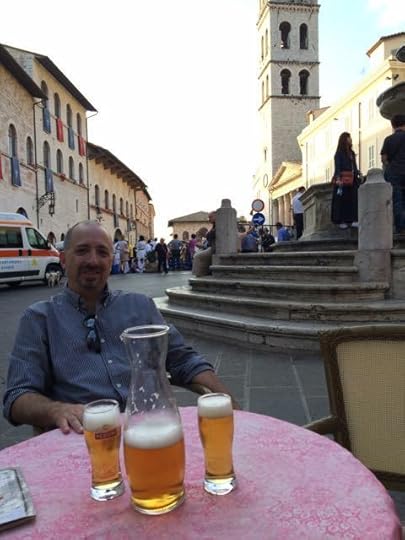
Okay, this one didn’t even make the blog headline. After days and days of wine, we decided to go a totally different route on our last night in Rome at La Botticella, a little Canadian-owned bar in an alley off Piazza Navona. Amaretto and Jack Daniels on the rocks. And, no, that is not our ashtray. Just comes with the territory in Italy.
Truck stop espresso on our way to Pompeii. Real glass cups. So civilized.
Espresso in Naples, as we wait for the boat to Capri. With a side of sfogliatelle. Yum.
White wine in Massa Lubrense to go with our delicious antipasto and seafood main course and glorious view. Perfect.
Assisi posts will go up on Monday and Tuesday, so be sure to come back.
The post A Moveable Feast: Coffee and wine and beer, oh my appeared first on Not Strictly Spiritual.

November 12, 2014
A Moveable Feast: Enchanted by Siena
When I put Siena on our pilgrimage itinerary, it was mainly because I wanted to visit the church where St. Catherine of Siena’s head rests. (The rest of her body is at Santa Maria Sopra Minerva in Rome, and I had already been there. I wanted to be able to say I had seen ALL of her.) Anyway, that was the motivation for making sure we had at least a half-day in the city of Siena, but, oh, once we got there, how I wished we had more time.
I loved Siena. It was so much more manageable than Florence — quieter, not as crowded, fewer panhandlers and potential pickpockets, more medieval. I could stay in Siena for a few days and just soak up Italian life from my seat at an outdoor cafe in Piazza del Campo.
Although we had only about four solid hours in the city of Siena itself before heading to the outskirts for lunch at a winery and agriturismo, we packed in a lot of great sightseeing. We started with Mass at the Basilica of San Domenico, which is where St. Catherine’s remains are located. Visiting this basilica was probably one of the most unexpected emotional moments of the entire pilgrimage for me. I was so moved by the experience, not just praying before St. Catherine’s remains, but touching the pillar that she once touched when she prayed, being in this space that was so special to her, this great woman saint and Doctor of the Church. If you are in Florence or Assisi or the general Tuscany region, be sure to set aside at least one day for this beautiful city. Here is a quick photo journey through Siena. (As always, you can click on the photos below to enlarge them.)
The Chapel of St. Catherine inside the Basilica di San Domenico. My friend Bill (aka Msgr. William Benwell) celebrated Mass for us at the basilica’s main altar.

Basilica San Domenico
The street where St. Catherine lived, just beyond the umbrella on the right.
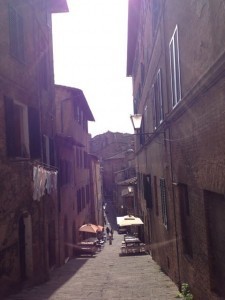
St. Catherine’s street
A gelato (or two) a day keeps the doctor away.

Gelato in the piazza
The main cathedral in Siena. Stunning.
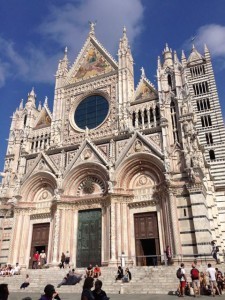
Siena Duomo
Lunch of wild boar at the Badia a Coltibuono winery in the outskirts of Siena.
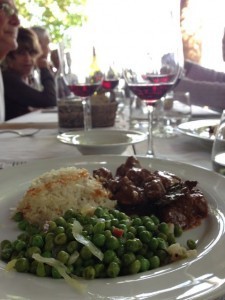
Wild boar for lunch
The winery was a former abbey. Breathtaking view, beautiful buildings.
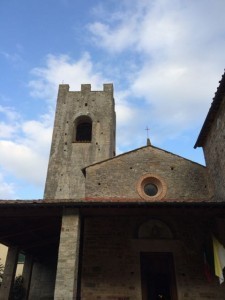
Former abbey
The winery’s garden.

Italian garden
My vintage in the wine cellar.

A very good year.
Next up: Assisi. Stay tuned…
The post A Moveable Feast: Enchanted by Siena appeared first on Not Strictly Spiritual.

November 11, 2014
My dinner with Billy: HUGE!
So Dennis and I were having dinner at Caffe Italia in Albany (worthy of its own blog post another time) after a long day of driving to and from Burlington for a college visit with Noah. As we sipped our wine and waited for our entrees, Dennis looked over at a back table and said, “That guy looks like Billy Fuccillo.” (If you live in upstate New York, this man needs no introduction. If you don’t, you’ll understand the fascination when you watch the video clip below.) Anyway, once we heard his voice, we knew it was, in fact, Billy Fuccillo, and I said, “I’m not leaving here without taking a photo with him.”
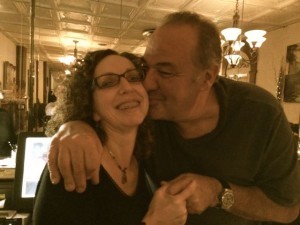 So we continued to eat and finish up and Billy was still sitting at his table in the back. Dennis kept egging me on to go ahead and ask for a photo. Eventually I got up, walked over, and said, “Mr. Fuccillo, I’m a big fan. Can I take a photo with you?” So we took a photo (see the one above), and then he asked if he could give me a kiss. (See photo on the right.) So, yeah, that was my silly adventure at Caffe Italia last night. Below you can see Billy doing his schtick. Then, scroll a little farther down, to see me doing my best impersonation outside the Kia dealership in Albany.
So we continued to eat and finish up and Billy was still sitting at his table in the back. Dennis kept egging me on to go ahead and ask for a photo. Eventually I got up, walked over, and said, “Mr. Fuccillo, I’m a big fan. Can I take a photo with you?” So we took a photo (see the one above), and then he asked if he could give me a kiss. (See photo on the right.) So, yeah, that was my silly adventure at Caffe Italia last night. Below you can see Billy doing his schtick. Then, scroll a little farther down, to see me doing my best impersonation outside the Kia dealership in Albany.
Now it’s my turn:
The post My dinner with Billy: HUGE! appeared first on Not Strictly Spiritual.


